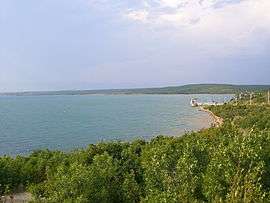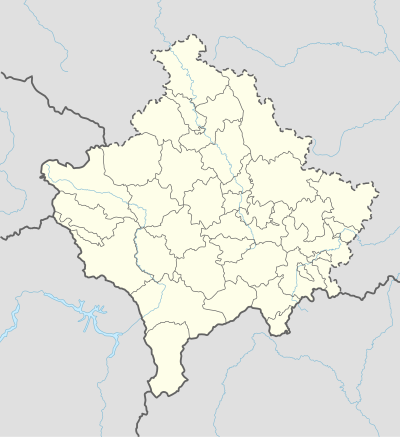Lake Radonjić massacre
The Lake Radonjić massacre or the Massacre at Lake Radonjić (Serbian: Масакр на Радоњићком језеру, Albanian: Masakra e Liqeni i Radoniqit) refers to the mass murder of at least 34 Kosovo Serb and Kosovo Albanian civilians near Lake Radonjić, by the village of Glodjane, in Kosovo, Federal Republic of Yugoslavia on 9 September 1998. The massacre took place during the Kosovo War. The perpetrator is suspected to be the Kosovo Liberation Army (KLA)
| Lake Radonjić massacre | |
|---|---|
 Photograph of Lake Radonjić | |
| Location | Lake Radonjić, near Glodjane, Kosovo, FR Yugoslavia |
| Date | September 1998 |
| Target | Kosovo Serbs, Kosovo Albanians and Roma civilians |
Attack type | Summary executions, mass killings |
| Deaths | 34[1]–39 killed[2] |
Background

In 1990, Kosovo's autonomy within Yugoslavia was revoked.[3] Soon after, the Kosovo Liberation Army (KLA) was formed to fight the Yugoslav establishment.[4] After a string of minor attacks, the KLA's mission became much more aggressive,[5] which led to them claiming areas that were key to Serbia's fuel-supply, near the town of Orahovac. Years of ethnic tension had preceded the Kosovo War, and spilled into numerous atrocities on both sides.
In September 1998, the Yugoslav Army (VJ) and police captured a series of villages around Lake Radonjić from the KLA beginning with Prilep, Irzniq and Glodjane.[6][7] KLA forces had grown stronger and tended to control villages away from the main roads while the Yugoslav military was positioned on the hills around Lake Radonjić.[8] Throughout the summer, Yugoslav forces shelled surrounding Albanian villages around Lake Radonjić from their position on the hills daily.[9] Meanwhile, the KLA launched increasingly bold attacks against Serbian targets and civilians. In September, the Yugoslav military moved through the villages around the lake in order to attack and expel the KLA. Colonel John Crosland, an English military officer attached to the VJ, witnessed this first hand and commented on the destruction caused by those forces.[10] He noted that he personally witnessed looting and burning of houses by Serbian forces and that the village of Prilep was razed to 18 inches about the ground.[11] He stated that the VJ, Serbian police forces and paramilitary police forces including MUP, PJP, SAJ, and JSO were involved in the offensive.[12]
Massacre
After the offensive, approximately thirty bodies were discovered by a Serbian forensic team.[13] They were likely the victims of the KLA, among whom were Idriz Gashi, Martti Harsia, and Avni Krasniqi.[14] The corpses were then taken away from Glodjane, and were thrown into Lake Radonjić.[15][5] Serbian authorities, however, refused access to international forensic teams, despite the fact that Helena Ranta, a famous international forensic expert, specifically requested access to the site [16] Instead, the Serbian forensic team conducted the investigation themselves which caused Human Rights Watch to raise questions about the credibility of the evidence recovered.[16]
The thirty bodies found in the Lake Radonjić canal consisted of individuals of Serbian, Albanian and Roma ethnicity.[17][18] The Trial Chamber of the International Criminal Tribunal for the former Yugoslavia (ICTY) and forensic records showed that they had been killed over a period of six months from April to September 1998 during the beginning of the armed conflict in Kosovo.[19][20]
Aftermath
After talks between Yugoslavia and the West broke down at the Rambouillet peace accords,[21] NATO commenced a 78-day-long bombing campaign of Serbian military and infrastructure targets. Serb forces withdrew from Kosovo on 11 June 1999. Kosovo declared independence from Serbia on 17 February 2008. The declaration was met with mixed-responses from International Governments.[22]
The 30 to 37 bodies discovered were widely viewed as victims of the KLA and they formed the basis of the ICTY indictment of three ethnic Albanians. The ICTY Trial Chamber assessed the evidence discovered at Lake Radonjić canal in detail over a three-year trial.[20] It found that seven of the bodies from the Lake Radonjić canal were proven to have been killed by the KLA.[23] These seven individuals were Zenun Gashi, Nurije Krasniqi, Istref Krasniqi, Sanije Balaj, and the mother and the two sisters of Witnesses 4 and 19.[24]
With respect to the other individuals, the court noted that some of the other individuals were likely killed by the KLA but cautioned jumping to conclusions because it had received evidence that some individuals could have been killed to settle old personal scores, or as the result of ordinary criminal behavior, or to further blood feuds in a region where law and order had broken down.[25][26]
The Court found that the evidence for the rest of the bodies found at the canal was problematic, as the evidence as to whom the perpetrators were was often non-existent .[27] The pattern of crimes suggested haphazard criminal behavior rather than organised KLA involvement.[28]
One forensic expert thought that some of the bodies found around the canal showed signs of having been moved to that location.[29][30] The defence lawyers at the court argued that this was evidence that Serbian security forces had “planted many of these bodies near the canal in order to frame the KLA.”[31] Serb security forces had been caught moving bodies in Kosovo before.[32] The Court rejected this argument and found that these bodies had legitimately been killed in the area during six months of armed conflict.[33]
See also
- List of massacres in the Kosovo War
- War crimes in the Kosovo War
References
- Human Rights Watch report
- Heike Krieger (2001). The Kosovo conflict and international law: an analytical documentation 1974–1999. Cambridge University Press. p. 38. ISBN 9780521800716. Retrieved 30 April 2011.
- Bethlehem & Weller 1997, p. xxii.
- "Unknown Albanian 'liberation army' claims attacks", Agence France Presse, February 17, 1996
- http://www.hlc-rdc.org/?p=13091
- "ICTY Fourth Revised Indictment para. 45". U.N. 16 October 2007. Retrieved 6 February 2013.
- "New Serbian Offensive Said to be Underway". L.A. Times. 9 September 1998. Retrieved 6 February 2013.
- "Trial Chamber Judgment - para 148". U.N. 3 April 2008. Retrieved 6 February 2013.
- "Trial Chamber Judgment - para 96". U.N. 3 April 2008. Retrieved 6 February 2013.
- "Public Testimony of John Crosland, transcript page 4666-4670". U.N. 23 May 2007. Archived from the original on 28 December 2013. Retrieved 6 February 2013.
- "Public Testimony of John Crosland, transcript page 4666-4670". U.N. 23 May 2007. Archived from the original on 28 December 2013. Retrieved 6 February 2013.
- "Public Testimony of John Crosland, transcript page 4666-4670". U.N. 23 May 2007. Archived from the original on 28 December 2013. Retrieved 6 February 2013.
- "Trial Chamber Judgment - para 146". U.N. 3 April 2008. Retrieved 6 February 2013.
- Heike Krieger (2001). The Kosovo conflict and international law: an analytical documentation 1974–1999. Cambridge University Press. pp. 38–. ISBN 978-0-521-80071-6. Retrieved 30 April 2011.
- Dejan Anastasijević (10 April 2008). "U ime zakona Leke Dukađina". Vreme. Retrieved 30 March 2013.
- Human Rights Watch (1999). A week of Terror in Drenica: Human Rights Violations in Kosovo. Human Rights Watch. ISBN 1-56432-227-0. Retrieved 6 February 2013.
- http://balkanwitness.glypx.com/Racak-FET-summary2.htm
- Human Rights Watch. World Events 1999. Retrieved 5 February 2013.
- "fourth amended indictment". U.N. 16 October 2007. Retrieved 6 February 2013.
- "Trial Chamber Judgment". U.N. 3 April 2008. Retrieved 6 February 2013.
- "Nato poised to strike". BBC News. 23 March 1999.
- Kosovo MPs proclaim independence, BBC, 2008-02-17
- "Trial Chamber Summary Judgment page 4". U.N. 3 April 2008. Retrieved 6 February 2013.
- "Trial Chamber Summary Judgment page 4". U.N. 3 April 2008. Retrieved 6 February 2013.
- "Trial Chamber Judgment para 234-235". U.N. 3 April 2008. Retrieved 6 February 2013.
- "Trial Chamber Summary Judgment page 4". U.N. 3 April 2008. Retrieved 6 February 2013.
- "Trial Chamber Judgment para 152". U.N. 3 April 2008. Retrieved 6 February 2013.
- "Trial Chamber Judgment para 152". U.N. 3 April 2008. Retrieved 6 February 2013.
- "Prosecution contests findings of own expert". sense tribunal. 19 September 2007. Retrieved 6 February 2013.
- "Public testimony of Dominique Lecomte transcript page 8783". U.N. 3 October 2007. Retrieved 13 February 2013.
- "How did the bodies get to Radonjic Lake?". Sense Tribunal. 26 June 2007. Retrieved 6 February 2013.
- "Who Directed Refrigerated Trucks from Kosovo?". Sense Tribunal. 12 February 2008. Retrieved 6 February 2013.
- "Trial Chamber Judgment para 150". U.N. 3 April 2008. Retrieved 6 February 2013.